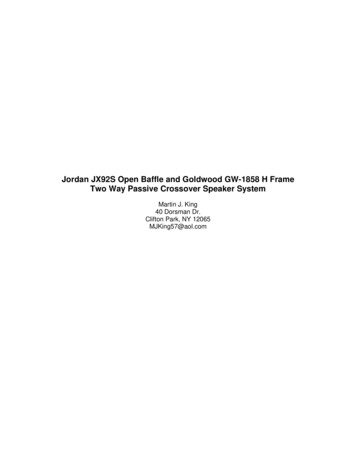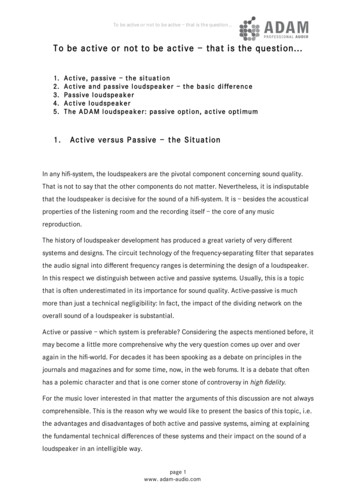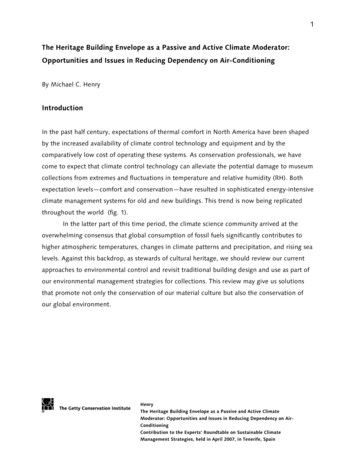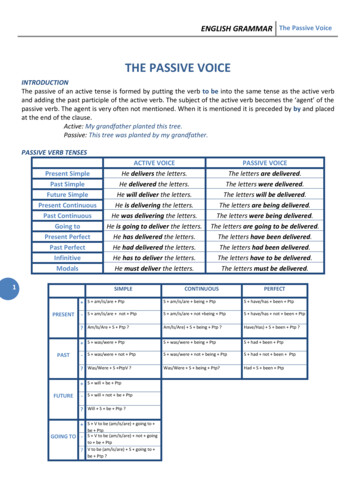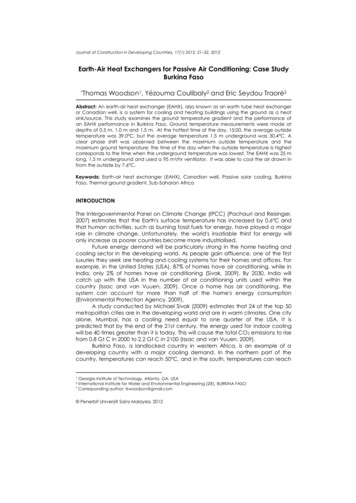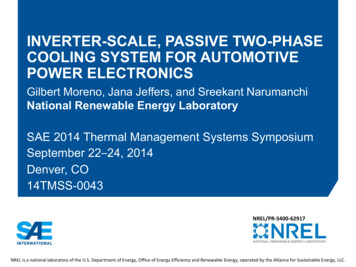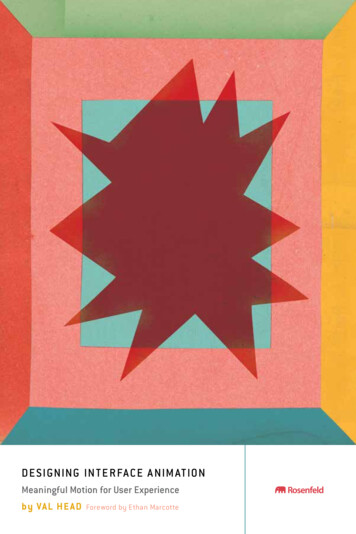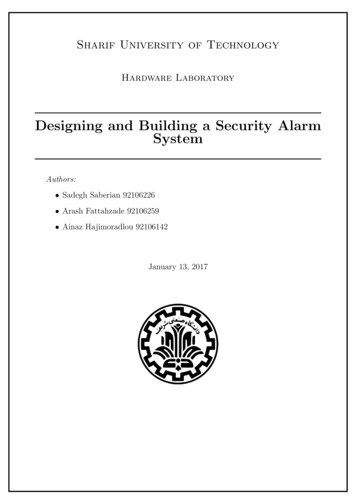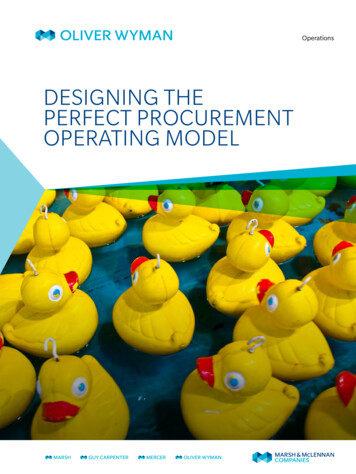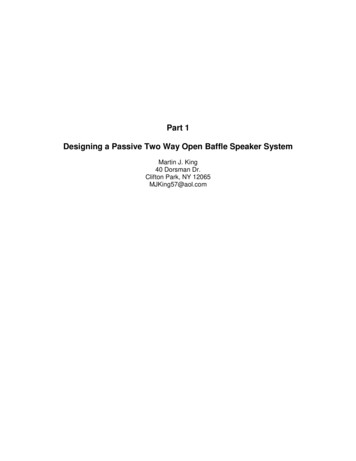
Transcription
Part 1Designing a Passive Two Way Open Baffle Speaker SystemMartin J. King40 Dorsman Dr.Clifton Park, NY 12065MJKing57@aol.com
Part 1 : Designing a Passive Two Way Open Baffle Speaker SystemBy Martin J. King, 09/15/07 (revised 09/17/07)Copyright 2007 by Martin J. King. All Rights Reserved.Introduction :A search of the Internet will reveal that there are a number of commerciallyavailable open baffle, hence forth abbreviated as OB, dipole speaker systems availablein the audio marketplace. Offerings such as Seigfried Linkwitz’s Orion(1), JohnKreskovsky’s NAO(2), and Paul Hilgeman’s Ronin(3) can all be characterized as floorstanding narrow baffle dipole speaker systems. Each features active crossovers and EQfilters requiring at least two amplifiers. These are all very sophisticated well engineereddesigns that allow the use of a narrow baffle while still producing satisfying bass output.The key to these designs is the use of active crossovers and EQ filters to producesufficient low frequency output.Some examples of OB speaker systems that use passive crossovers are DannyRichie’s OB-5 and OB-7(4), the Jamo R 909(5) and Hawthorne Audio’s Solo(6). These arealso narrow, at least when considering some of the woofer diameters, OB speakersystems that claim bass performance down into the 25 - 30 Hz range. Being passivecrossover designs, these speakers do not have requirements for sophisticated electronicfilters and multiple amplifiers. Instead they rely on the acoustics of the baffle and apassive crossover to generate a balanced SPL frequency response. While the cost ofmultiple amplifiers is no longer a factor in these designs, the most expensive of all theOB speakers mentioned is the Jamo R 909 speaker system which on sale is still 7500(the list price is approximately 13,000).Even though I have not heard any of these OB speaker systems, I am sure theperformance of each is outstanding and easily justifies the cost. But the combination of abaffle’s acoustic design and a passive crossover, as used in the Jamo R 909, to tune thebass response was just too intriguing for me not to try and understand the trade-offs.Reading the online copy of a Jamo R 909 white paper started me thinking about how toachieve this simple yet elegant design concept. As a first step I have performed a designstudy, using some of the concepts learned from studying the Jamo white paper andowner’s manual, for a passive two way OB system that is very modestly priced. Thisdesign study is discussed on the following pages. The next logical step would be todesign a bigger all passive crossover three way OB speaker system. That may be thetopic of a future study, project, and document.DIYer Designs on the Net :Looking around the Internet for DIYer designs of OB speakers yields a widevariety of different baffle sizes, baffle shapes, number of drivers, types of drivers, andpassive or active crossovers being used. The level of sophistication in the designprocess spans from a trial and error design based on experience/experimentation all theway up to a design based completely on computer simulation predictions of SPLresponse curves. Both methods work and can generate finished OB speaker designswith exceptional performance. The design of an OB speaker system can be as quick andeasy as constructing a temporary baffle from cardboard, listening to the response, andmaking immediate adjustments to address shortcomings in what the designer/builderhears. Quick, easy to build, and cheap are all appealing attributes of OB systems for alot of DIY speaker builders.Page 1 of 15
Part 1 : Designing a Passive Two Way Open Baffle Speaker SystemBy Martin J. King, 09/15/07 (revised 09/17/07)Copyright 2007 by Martin J. King. All Rights Reserved.An OB speaker system is a fairly forgiving design where probably the worstpossible outcome is disappointing bass performance. But additional bass response canbe added later with a dedicated subwoofer so a fix is fairly easy. The drivers produceSPL frequency responses consistent with manufacturer’s specification sheets withoutany interaction with a tuned enclosure. The baffle itself tends to only roll off the driver’slowest frequencies starting at a frequency value determined by the physical size andshape of the baffle. Without the potential for mistuning an enclosure, the resultingbooming or anemic bass performance problems of boxed speakers are avoided.A compromise position between a completely experimental design method and acompletely computer simulation based design method is the use of tools like the EDGE(7)computer program. The EDGE program helps define the influences of the baffle’s sizeand shape on the system’s low frequency response. Using a baffle response calculator,like the EDGE, does not factor in the influence of the driver’s response so it is only onepiece of the puzzle. Sometimes the other puzzle pieces are neglected when the DIYdesigner focuses solely on the calculated baffle response. Using programs like theEDGE requires the designer to somehow sum the baffle’s response with the speaker’sresponse to generate the system’s response. In my opinion, too much emphasis issometimes placed on the calculated baffle response curves without considering thecomplex summation that needs to occur to produce the complete system response.I really like full range drivers and the lack of a crossover in the midrangefrequencies, so I am going to slant this approach to the use of full range drivers as wideband devices with the bass reinforced by an additional driver. In my opinion, there is noaffordable single full range driver available that can be mounted in a reasonably sizedOB speaker system and still reproduce balanced bass, midrange, and treble responses.While the midrange can be handled nicely by a single full range driver in an OB, one endor maybe both ends of the audio spectrum will be compromised. Therefore, for this studythe bass performance requirement will be met by using a woofer driver that is crossedover between 100 and 200 Hz to the full range driver.Selecting Drivers :In the design of multi-way OB speaker systems using passive crossovers, I havenot seen a method presented for selecting bass and full range drivers that will assure asmooth and balanced SPL response. Therefore, a method for selecting the appropriatebass driver for a particular baffle size and shape so that the combined efficiencymatches the full range driver’s midrange efficiency will be presented. The starting pointis the full range driver; the efficiency of the midrange frequencies sets the requirementfor the entire system SPL response.To begin the design process, we need to first define the desired end result. Foran OB speaker system the bass will roll-off at a rate of 18 dB/octave, this is the sum of a12 dB/octave roll-off for the driver and a 6 dB/octave roll-off for the open baffle. If weassume an efficiency target, a goal function can be constructed. Figure 1 depicts a 90dB/W/m goal function, tuned to 45 Hz, which will be assumed for this sample OB design.This 90 dB response is to be achieved at a one meter distance along the axis of the fullrange driver. The full range driver will be located 32 inches above the floor which isapproximately at ear level when seated. There is nothing magical about this goalfunction other then the efficiency being consistent with the selection of the full rangedriver. A different efficiency, tuning frequency, or listening position could just as easilyPage 2 of 15
Part 1 : Designing a Passive Two Way Open Baffle Speaker SystemBy Martin J. King, 09/15/07 (revised 09/17/07)Copyright 2007 by Martin J. King. All Rights Reserved.have been selected. The challenge is to design a baffle that couples with a woofer andwill produce the defined 90 dB efficiency and the desired low frequency roll-off.SPL (dB)Figure 1 : The OB Speaker System SPL Goal Function1101051009590SP Lg 85r8075706560101 103100 1r d HzFrequency (Hz)By setting the goal function’s efficiency between 88 and 92 dB, many smaller 3”,4”, and 5” full range drivers are excellent candidates for an OB design. Table 1 presentssome options from the Fostex family of full range drivers.Table 1 : Manufacturer’s Specifications for Fostex 24.705.205.924.14N/ampXmax0.350.350.280.350.67mm pk-pkSPL8990909391dB/W/mUnit Cost38.2040.4588.1542.7545.00US ’sOther Possible Fostex Drivers : FE83E, FE87E, FF85K, FF125K, F120A, F200AReviewing the drivers listed in Table 1, and recognizing that a woofer will beused to eliminate the need to produce bass frequencies, the manufacturer’s Thiele /Small parameters for the full range drivers are no longer as important in the designprocess. There are three drivers shown in Table 1 that have efficiencies of 90 dB/W/m.Since low cost was also a goal of the design, I selected the FE103E for this study.Having selected the full range driver and defined the target SPL and bass roll-off,requirements for the bass driver can now be considered. One requirement is that theefficiency of the woofer must be greater than the design goal of 90 dB/W/m. Considerthis efficiency requirement for a minute. If the bass driver were mounted in an infinitebaffle a 90 dB/W/m efficiency would be adequate. But as the baffle size decreases, thesupport for the bass frequencies drops leading to a requirement that the wooferefficiency must be significantly higher than the 90 dB goal function. For a passivePage 3 of 15
Part 1 : Designing a Passive Two Way Open Baffle Speaker SystemBy Martin J. King, 09/15/07 (revised 09/17/07)Copyright 2007 by Martin J. King. All Rights Reserved.crossover OB system, the smaller the baffle the more efficient the woofer must be tosatisfy the SPL goal function. This requirement for increased woofer efficiency can behandled by multiple woofers in parallel or by using a single larger diameter pro-audiowoofer. I selected the second option for the woofer, a larger diameter pro-audio wooferwill have the required efficiency, a lower cost, and in the end I believe it will lead to asimpler baffle design.For this study, I focused on three of the Eminence pro-audio woofers thatspanned a range of Qts values typically used in DIYer OB speaker systems. All three aresignificantly more efficient than the specified 90 dB/W/m goal function. Themanufacturer’s Thiele / Small parameters for the three woofers are summarized in Table2. The basic difference between these three models of Eminence woofers is the magnet,as the magnet size and strength increases the Qts decreases while the price increases.This is a very simplistic characterization but I believe it is a reasonable assessment ofthe important trade-offs between the three drivers.EminencefsReQedQmdQtdVadBLXmaxSPLUnit CostTable 2 : Eminence 15 “ WoofersAlpha 15ABeta -ampmm pk-pkdB/W/mUS ’sAll three Eminence woofers were simulated in combination with the FostexFE103E full range driver and a passive crossover network. After iterating each designmany times, the pairing of the Fostex FE103E and the Eminence Alpha 15A providedthe closest match with the SPL goal function and the smallest baffle dimensions. Byexamining the behavior of this design in detail, an understanding of why it works can begained. Then substituting each of the other two woofers into the design, potential tradeoffs required to provide similar low frequency performance levels can be discussed.Figure 2 shows the final baffle layout for the Fostex FE103E full range driverpaired with the Eminence Alpha 15A woofer. The baffle is 20” wide and 38” tall. Thewoofer is centered 10” above the bottom edge of the baffle. The full range driver is 32”above the bottom edge of the baffle and shifted 2” off center. Recognize that this OBdesign would need to be constructed in mirror image pairs.Figure 3 is the calculated system SPL response at 1 m on the axis of the fullrange driver. The red curve is the calculated response and the black curve is the SPLgoal function. The response in Figure 3 assumes ideal 2nd order crossovers, crossoverswith real components interacting with the driver’s electrical impedances will be shownlater. The other interesting feature of Figure 3 is the apparent 92 dB/W/m efficiency ofthe Fostex FE103E driver. For this study, assume that this portion of the SPL responsePage 4 of 15
Part 1 : Designing a Passive Two Way Open Baffle Speaker SystemBy Martin J. King, 09/15/07 (revised 09/17/07)Copyright 2007 by Martin J. King. All Rights Reserved.will be 2 dB lower matching the manufacturer’s data sheet. Factoring in these twoobservations, it is clear that the design follows the SPL goal function closely.Figure 2 : Woofer and Full Range Driver Locations on a 38” x 20” Open BaffleAxis Dimensions are MetersExtended Range Driver and Woofer : Simple Source Pattern with Baffle Edge Outline1.210.8ydym0.6yo0.40.200.20.40.60.811.2xd xm xoFigure 3 : Preliminary Calculated System SPL Response110SPL (dB)1051009590SP LrSP Lgr858075706560101 103100 1r d HzFrequency (Hz)Page 5 of 151 104
Part 1 : Designing a Passive Two Way Open Baffle Speaker SystemBy Martin J. King, 09/15/07 (revised 09/17/07)Copyright 2007 by Martin J. King. All Rights Reserved.Getting the Bass Right :To understand the contributions that the woofer and the baffle are each makingto the system’s low frequency response, you need to separate the contributions andshow each individually superimposed over the SPL goal function. Figure 4 shows theEminence Alpha 15A calculated SPL response in an infinite baffle (dashed blue curve),in an infinite baffle with a floor reflection (solid red curve), and the SPL goal function.Compared to the SP
systems that claim bass performance down into the 25 - 30 Hz range. Being passive crossover designs, these speakers do not have requirements for sophisticated electronic filters and multiple amplifiers. Instead they rely on the acoustics of the baffle and a passive crossover to generate a balanced SPL frequency response. While the cost ofFile Size: 294KBPage Count: 16
